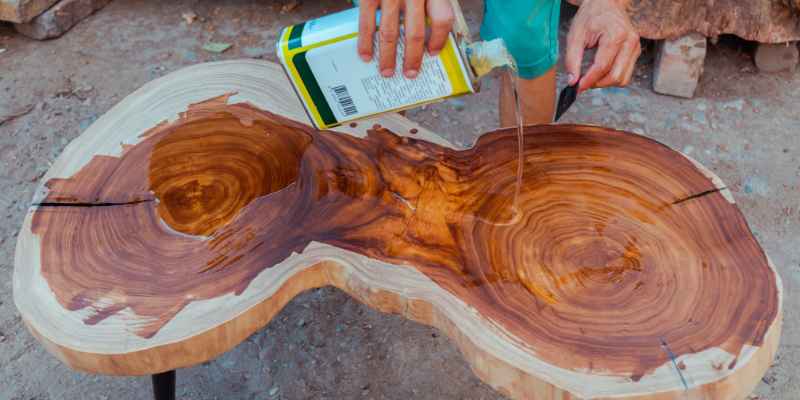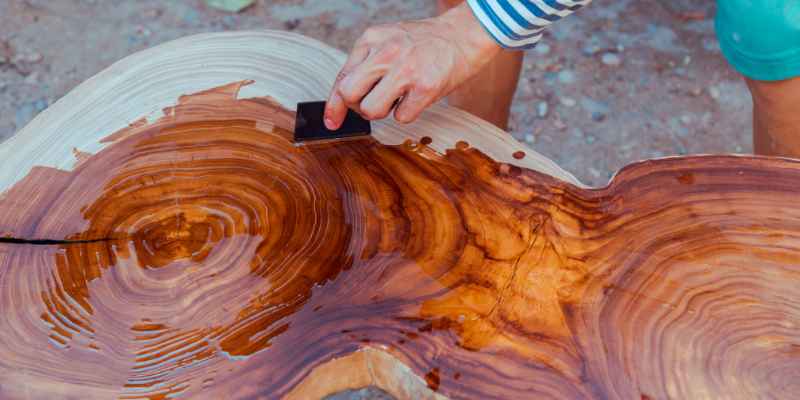Linseed oil finish is a hand-rubbed oil finish that deeply saturates the wood grain and protects against scratches and humidity changes, producing a satin finish. However, it has some disadvantages such as taking a long time to dry, lack of UV inhibitors, and mildew growth.
It may not harden enough on surfaces with frequent abrasion, requiring frequent repairs. Linseed oil should be reapplied at least once a year, depending on the volume of use the surface sees. Tung oil is more preferable for outdoor applications where durability and moisture resistance are crucial, while linseed oil is more suitable for indoor projects.
Despite its disadvantages, linseed oil remains a popular choice for many woodworkers.
Benefits Of Linseed Oil Finish
When it comes to wood finishes, linseed oil is a popular choice that has been used for centuries. Linseed oil is extracted from flaxseeds and is a natural oil that saturates deep into the wood grain, providing protection against scratches and humidity changes. Here are some benefits of linseed oil finish that make it a great choice:
Saturates Deep Into Wood Grain
Linseed oil is known for penetrating deep into the wood, which provides protection against scratches and damages. As the oil saturates into the wood grain, it brings out the natural color and grain, enhancing the overall appearance of the wood. This finish is perfect for woodworkers who want to bring out the natural beauty of their pieces.
Easy To Care For
Linseed oil is easy to care for and maintain compared to other finishes, making it an excellent choice for everyday use. You can use a wood cleaner or a damp cloth to clean the surface. There is no need for sanding or stripping when reapplying the finish.
Eco-friendly
Linseed oil is a natural and environmentally friendly product that is biodegradable and non-toxic. This makes it an ideal choice for those who are conscious about their environmental impact. The high demand for eco-friendly products has made linseed oil a popular choice among woodworkers.
Produces A Satin Finish
Linseed oil produces a beautiful satin finish that enhances the natural beauty of the wood. It is perfect for indoor projects where a glossy finish is not desired. The finish provides a soft sheen that brings out the richness of the wood, highlighting its unique character.
If you are looking for an easy-to-use, natural, eco-friendly finish that provides a beautiful satin sheen and saturates deeply into the wood grain, linseed oil finish is a great choice.

Types Of Linseed Oil
Linseed oil finish is a popular option for protecting and enhancing the natural beauty of wood. There are different types of linseed oil available, including raw, boiled, and polymerized linseed oil, each with its own pros and cons. It is important to choose the right type of linseed oil to achieve the desired finish and durability.
Linseed oil is a popular wood finish due to its natural properties that provide excellent protection and an attractive finish to various woodworking projects. There are three types of linseed oil: Raw Linseed Oil, Boiled Linseed Oil, and Polymerized Linseed Oil. Each has a different application method, drying time, and finish.
Raw Linseed Oil
Raw linseed oil is unprocessed and contains no additives, making it the most natural form of linseed oil. It provides a low-gloss finish that accentuates the natural beauty of the wood. Raw linseed oil takes longer to dry than boiled linseed oil, and the finish yellowing over time is a common issue. Raw linseed oil is ideal for porous woods because it penetrates deep and seals the wood.
Boiled Linseed Oil
Boiled linseed oil contains drying agents that reduce drying time significantly. It has a glossy finish that highlights the wood’s grain but can darken the color over time. Boiled linseed oil is not pure or natural, so it’s essential to purchase high-quality boiled linseed oil to avoid potential problems such as cracking or flaking. Unlike raw linseed oil, boiled linseed oil forms a hard coating and is suitable for use on both porous and non-porous woods.
Polymerized Linseed Oil
Polymerized linseed oil is a type of boiled linseed oil that has undergone further processing to transform the oil into a varnish-like substance. The heat-treatment makes the oil thicker and more durable than boiled linseed oil, reducing the risk of cracking or flaking. It provides the most durable finish of all the linseed oil options and can be used on a variety of woodworking projects.
In conclusion, the type of linseed oil used will depend on the project’s requirements, such as drying time and the desired finish. Regardless of the type chosen, linseed oil is an eco-friendly, easy-to-use finish that enhances the wood’s beauty while also providing excellent protection against scratches, dents, and other wear and tear.
Disadvantages Of Using Linseed Oil On Wood
Using linseed oil as a wood finish comes with its disadvantages. It can take a long time to dry, lacks UV inhibitors and can promote the growth of mildew. In addition, on high-abrasion surfaces, linseed oil can fail to harden properly, necessitating frequent repair.
While linseed oil is a popular finish for wood due to its easy application and eco-friendliness, it also has some drawbacks. Here are some disadvantages to consider before using linseed oil on wood:
Takes Time To Dry
One major drawback of linseed oil is that it takes a long time to dry. Raw linseed oil can take anywhere from several days to a few weeks to fully dry, which can make it less convenient for projects that require a quick finish. Boiled linseed oil, on the other hand, dries much faster, but it has its own set of drawbacks.
Lack Of Uv Inhibitors
Another disadvantage of linseed oil is that it lacks UV inhibitors, leaving the finished wood vulnerable to sunlight. UV rays can cause the wood to fade, discolor, and even crack over time. It’s important to keep this in mind when using linseed oil on wood furniture that will be exposed to sunlight.
Can Support Mildew Growth
Linseed oil can also support the growth of mildew, which can be a problem for wood surfaces that are exposed to moisture. This can be especially concerning if the wood is in a humid environment or prone to getting wet.
May Require Frequent Repair
Lastly, linseed oil may require frequent repair on surfaces where abrasion will be frequently encountered. The oil may not harden sufficiently, leading to scratches or other damage that will need to be repaired periodically.
When using linseed oil on wood, it’s important to weigh the potential drawbacks against the benefits to determine if it’s the right finish for your project.
Using Linseed Oil On Wood
Linseed oil is a popular natural finish for wood due to its ability to penetrate deeply and protect the wood against scratches and changes in humidity. However, it can take a long time to dry and lacks UV inhibitors, making it unsuitable for outdoor use.
Mildew growth and frequent repair may also be potential drawbacks on high-abrasion surfaces.
Choosing The Right Type Of Linseed Oil
Before using linseed oil on wood, it’s important to choose the right type of linseed oil. There are three types of linseed oil you can use: raw, boiled, and polymerized. Raw linseed oil dries slowly and brings out the natural color of the wood. Boiled linseed oil dries more quickly than raw linseed oil because it has additives that help it dry faster. Polymerized linseed oil has even more additives that increase its durability and make it dry even faster.
Preparing The Wood Surface
To get the best results, the wood surface should be clean, dry, and free of any dust or debris. Any previous finish should be removed by sanding or stripping to ensure the oil can penetrate the wood. You can then wipe the surface with a clean cloth to remove any remaining dust.
Applying And Curing The Oil Finish
Once the wood surface is prepared, applying the linseed oil is easy. Using a lint-free cloth, apply a thin layer of linseed oil to the wood, working with the grain. Allow the oil to soak in for 15 to 20 minutes, then wipe off any excess with a clean cloth. Allow the wood to dry completely before applying another coat.
The curing time for linseed oil can vary depending on the type of oil and the environmental conditions. Generally, it can take a few days to a few weeks for the oil to fully cure. After the final coat, it’s important to allow the surface to cure completely before using or placing objects on it.
Linseed oil is a good finish for wood because it saturates deep into the wood grain, protecting it from scratches and changes in humidity. It is easy to care for, eco-friendly, and produces a satin finish that brings out the color and grain of the wood. However, there are some disadvantages to using linseed oil on wood. These include its slow drying time, lack of UV inhibitors, the potential for mildew growth, and the need for frequent repair on surfaces subject to frequent abrasion.
Overall, using linseed oil on wood can provide a beautiful, durable finish that enhances the natural beauty of the wood. With the right preparation and application, linseed oil can provide a long-lasting finish that protects the wood for years to come.
Comparing Linseed Oil With Tung Oil
Linseed oil finish can be compared to tung oil for its durability, but it takes longer to dry and lacks UV inhibitors. Linseed oil saturates deep into wood grain, producing a satin finish ideal for indoor projects.
Benefits And Drawbacks Of Tung Oil
Tung oil is an excellent choice when it comes to outdoor woodwork, moisture resistance, and durability. It dries faster than linseed oil, making it less prone to stickiness and tackiness, and doesn’t support mildew growth. Moreover, it doesn’t yellow over time and provides a clear, transparent finish. However, tung oil doesn’t penetrate deep into the wood, but instead, forms a thin coat on the surface, hence doesn’t protect against scratches or abrasions.
Benefits And Drawbacks Of Linseed Oil
Linseed oil is perfect for indoor woodwork, providing a classic, hand-rubbed, and satin finish that shines the wood’s natural color and grain. It penetrates deep into the wood, making it more resistant to scratches and humidity changes. However, it takes longer to dry, and the unboiled linseed oil can remain tacky even after weeks, making it unsuitable for surfaces that require frequent use. Moreover, unboiled linseed oil has no UV inhibitors, which makes it vulnerable to sun yellowing and mildew growth.
If you are looking for a finish that will protect your indoor wood surfaces and enhance their natural beauty, then linseed oil is an excellent choice. However, if you need a finish for your outdoor projects that can resist moisture and UV exposure, then tung oil is the way to go.
Remember, before applying any finish, ensure that the wood surface is clean and free of dust and debris. Also, test the finish on a small portion of the wood to ensure that you achieve the desired results.
Popular Brands Of Linseed Oil
Linseed oil finish is a common choice for protecting wood furniture, providing a satin finish that accentuates the natural color and grain of the wood. Popular brands of linseed oil include Pure Swedish Raw Linseed Oil, Walrus Oil Polymerized Linseed Oil, and Klean Strip Boiled Linseed Oil.
Popular Brands of Linseed Oil
Linseed oil finish is a popular choice among woodworkers to enhance the natural beauty of wood and protect it from scratches and humidity. There are several brands of linseed oil in the market, each with unique features and benefits. Here are some popular brands and their details:
Walrus Oil
Walrus Oil Polymerized Linseed Oil is a food-safe, easy-to-use linseed oil finish that is perfect for cutting boards, wooden spoons, and other kitchen tools. It has a satin finish and is formulated to dry faster than traditional linseed oil.
Klean Strip
Klean Strip Boiled Linseed Oil is a versatile linseed oil finish that can be used on indoor and outdoor projects. It is boiled to speed up the drying time and contains additives that prevent mildew growth.
Sunnyside
Sunnyside Pure Raw Linseed Oil is a natural, unboiled linseed oil that is perfect for preserving and protecting wood. It is easy to apply and produces a beautiful, natural finish.
Winsor Newton
Winsor Newton Linseed Oil is a refined linseed oil that is perfect for artists and painting enthusiasts. It can be used as a binder, thinner, or as a glossy finish for oil paintings.
Allbäck
Allbäck Boiled Linseed Oil is a traditional, eco-friendly linseed oil finish that is perfect for historic and traditional buildings. It is made from 100% natural and renewable ingredients and provides excellent protection against weathering.
Kremer Linseed Oil Varnish
Kremer Linseed Oil Varnish is a high-quality, professional-grade linseed oil finish that provides a durable and long-lasting finish for wood. It is easy to use and produces a beautiful, glossy finish.
Tried & True Original Wood Finish
Tried & True Original Wood Finish is a unique linseed oil finish that is made from all-natural, food-grade ingredients. It is perfect for use on cutting boards, wooden bowls, and other kitchen items, as well as furniture and other wood projects.
In conclusion, choosing the right brand of linseed oil depends on your specific needs and preferences. Whether you’re looking for a food-safe finish for kitchen tools or a professional-grade finish for furniture, there is a linseed oil brand that will meet your requirements.

Frequently Asked Questions For Linseed Oil Finish
What Are The Disadvantages Of Using Linseed Oil On Wood?
Disadvantages of using linseed oil on wood include slow drying time, lack of UV inhibitors, potential for mildew growth, and poor hardening on frequently abraded surfaces. Boiled linseed oil is a faster-drying alternative. Reapplication may be necessary, making it less ideal for outdoor use.
Overall, linseed oil produces an eco-friendly, hand-rubbed satin finish for indoor use.
Is Linseed Oil A Good Finish?
Yes, linseed oil is a good finish for wood furniture. Linseed oil saturates deep into the wood grain to protect against scratches and changes in humidity. It is easy to care for, eco-friendly, and produces a satin finish that brings out the color and grain of the wood underneath.
However, linseed oil takes time to dry, lacks UV inhibitors, and may not harden sufficiently on surfaces where abrasion is frequently encountered. It should be reapplied at least once a year for optimal results.
How Long Does A Linseed Oil Finish Last?
A linseed oil finish can last for a year and needs to be reapplied once or multiple times yearly, depending upon the usage of the surface. It is not recommended for outdoor use and should not be exposed to regular water or sun.
It can bring out the color and grain of the indoor wooden furniture and is eco-friendly.
What Is Better Tung Oil Or Linseed Oil?
Tung oil is better for outdoors as it is durable and moisture-resistant, while linseed oil is more suitable for indoor projects as it dries faster and provides more sheen. Linseed oil requires multiple annual applications and lacks UV inhibitors, but protects against scratches and changes in humidity.
Conclusion
To sum up, Linseed Oil Finish is a great choice for those looking for an eco-friendly and affordable way to protect and enhance the natural beauty of their wood furniture. While not recommended for outdoor use, it provides a satin finish and deep wood penetration against scratches and humidity changes.
However, it does have its disadvantages, such as the lengthy drying time and lack of UV inhibitors, which may lead to mildew growth. Overall, Linseed Oil Finish is a great choice for indoor furniture that is frequently exposed to abrasion.


